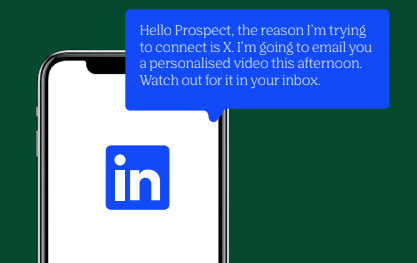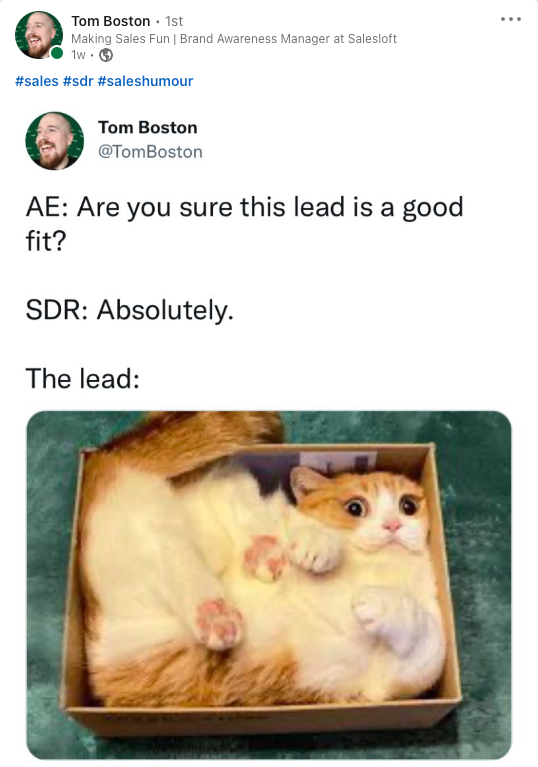Best Practices to Succeed in the Sales Prospecting Process
Published:

Over 40% of salespeople find prospecting to be the most challenging part of the sales process. It requires time, effort, and resources to find prospects who are a good fit for your business.
Fortunately, prospecting is less of a monolith if you define the sales prospecting process and best practices. Let’s start today.
What Is Sales Prospecting?
Sales prospecting refers to the first stage of the sale process where sales reps seek out, initiate contact, and bring potential customers into the sales pipeline.
Reps use methods such as cold calling, cold emailing, SMS, and social media (better known as social selling) to initiate contact with new prospects.
The Importance of Sales Prospecting
Sales prospecting is important because it allows B2B sales reps to identify customers who are a good fit for your business.
Not every new lead will be in a position to buy. The sooner a salesperson knows as much, the less time they’ll waste on a dead-end deal.
Furthermore, outbound prospecting helps SDRs and BDRs target their efforts where they’ll have the most impact, i.e. potential buyers who not only need but want your solutions. Targeting these best-fit prospects secures long-term business, retention, and future sales opportunities.
Lastly, buyers appreciate prospecting. The Rain Group reports that 82% of buyers accept meetings if a salesperson initiates contact first. Your reps will have an easier time topping off their pipeline with qualified leads if they’re proactive from the get-go.
The Sales Prospecting Process
The sales prospecting process looks different for every sales organization. And while we can’t tell you how to prospect, we can say that without a definitive process in place, prospecting will be laborious and ineffective. If you don’t have a buyer engagement strategy in place, now is the time to create one!
Let’s break down the sales prospecting process below.
1. Build your ideal customer profile.
An ideal customer profile (ICP) is a fictitious representation of a customer who would benefit most from your product. ICPs help sales professionals know what to look for in a potential buyer—from the prospect’s needs and attributes (e.g company size, sector) to how your solutions can align with their pain points.
ICPs save time during prospecting. If salespeople know what they are looking for, they can narrow their search, organize new leads, and put effective lead generation into place.
2. Research your prospect to see where you can provide value.
Once you have identified potential prospects, it’s time to research to find where you can provide the most value. For example, maybe you see a prospect comment on a LinkedIn post about a pain point you can solve. Or maybe you see that a prospect has downloaded several whitepapers on the same topic.
It’s worth mentioning that your reps can only ascertain so much at this stage. So to determine whether the prospect is workable (and streamline the process a bit), take advantage of research tools.
6sense provides helpful intel on accounts I’m working, giving me important information on intent, buying stage, and their interests so I can tailor a custom approach specific to their needs.
3. Prioritize your prospects based on their likelihood to buy.
Not all prospects are equal. Some are more engaged with your brand than others. Some are ready to buy, while others are not. Effective sales prospecting involves creating and organizing prospect lists to ensure reps are spending time with the buyers most likely to make a purchase.
Predictive analytics can help you get a head start on prioritization. For example, deal engagement scores take into consideration factors like the number of emails opened in the past 14 days, number of days since the last meeting, or how long a deal has been in a particular stage. These real-time insights can indicate buying likelihood – or signal trouble.
4. Plan for the first touchpoint.
No one wants to talk to a robot, much less interact with an email about your brand’s irrelevant capabilities. You’re most likely to catch a prospect’s attention if the first touch is timely, casual, and personalized to their business.
You should also consider your method of approach. We’ve found that 80% of the top 100 cadences (out of 3.4 million samples) begin with a call followed by a sales email. Open with a friendly, short phone call then direct prospects to the email to better secure a response!
5. Personalize your communications.
Use some of the intel gained on your research to personalize your communications. And not just adding the prospect’s first name. Hint at the pain they may be feeling based on their role or comment on something you saw in their LinkedIn profile or on an article they wrote.
Salesloft data shows that reply rates increase by 2.75x when you personalize your email response by 15% (compared to zero personalization). Combine prospect sentiment and the level of personalization to better understand what is working, then build email templates for the whole sales team. Personalization is a quick way to maximize your sales prospecting activities.
Note that good personalization means striking a balance between effort and outcome. Use less personalization for lower tier accounts. Likewise, not all personalization methods will scale well. Check your effort against expected ROI and course correct as needed.
6. Keep track of what worked and what didn’t.
There’s going to be some trial and error throughout the sales prospecting process. Keeping track of what was successful and what wasn’t will help you define prospecting strategies and improve your results.
Reflect on the impact of each touch. Which prospecting emails garnered the highest positive reply rate and which had the lowest? How many days should you wait to follow-up? How many leads do you need to bring into the sales funnel to meet quota? When all your buyer engagement data is in one platform alongside deal data, it is easy to analyze and identify best practices.
Sales Prospecting Techniques and Best Practices
As you go through the sales prospecting process, you’ll gradually figure out what works for you and your sales team.
To assist you in this process, though, below you will find sales prospecting techniques and best practices.
Make warm calls instead of cold calls.
Now, cold calling is far from dead—but warm calls can help you get your foot through the door faster. To warm up a prospect, familiarize yourself with decision-makers and your point of contact. Next, leverage social media or a mutual connection to initiate an introduction.
Here’s an example of this technique: Jack Neicho, an AE at Salesloft, likes to start with a LinkedIn connection request in the morning (bonus if they personalize the message). Jack then follows up with an afternoon email containing a video message. The prospect will feel more comfortable interacting with the email since they already know who Jack is.

Incorporate video when you can.
You might be thinking, “Why would Jack send a video message?”
Well, Salesloft research finds that by incorporating a video step or a direct mail step into your cadence, you can increase your success rate by 161%. Phone, email, and LinkedIn are vital to prospecting efforts and should not be neglected, but including a video—and making note of it in the subject line—entices the prospect and enables a more human introduction.
Salesloft data shows that video boosts email reply rates by as much as 25%. We also found that video performs best on Day 5 of a cadence, though anytime between Day 2 and Day 20 is optimal.
To appear more casual, Jack recommends recording a video on your phone and adding “sent from my [iPhone]”. We also suggest limiting your email copy to 200 to 600 characters before the embedded video.
Become a trusted resource.
Prospecting isn’t just about selling—it’s about establishing yourself as a trusted authority on your particular solutions.
Build your personal brand on LinkedIn (or another social media platform) and be known to prospects before you reach out. In doing so, you’ll frame yourself as a trusted advisor your customers can rely on.
They’ll enter and leave a sale with a positive impression, which can lead to referrals and even future sales opportunities if you decide to reach out again.

Follow up at the right time.
It is highly unlikely that your first attempt to reach a prospect will result in a booked meeting. That’s why the best sales prospecting practices require consistent and timely follow-up. By knowing the difference between pestering and persistent follow up, you build a stronger relationship with the prospect and reaffirm your position as a trusted resource.
In each follow up, provide some type of value for the prospect. Maybe you share an interesting article or new information. To help you stay consistent, automate and personalize follow-up in Salesloft Cadence.
Ask for referrals.
Referrals are an invaluable source of new business. Stay in touch with buyers beyond onboarding. With an occasional check-in you can see how they’re faring to show you care, maintain your authority as a trusted advisor, and allow you to learn more about their professional network.
A prospect you have a positive relationship with can turn into a brand champion and introduce you to new connections.
Automate More Conversions with Salesloft
While prospecting certainly takes time, it also saves time by making it possible for sellers to focus on the potential buyers most likely to find value in the product. To simplify and consolidate prospecting efforts, organizations turn to sales prospecting tools like Salesloft.
The Salesloft Platform brings all buyer engagement and deal data into one platform that sellers can use from first contact to close. Conduct research right within the platform using integrations like LinkedIn Navigator, Zoominfo, and more. Manage all multi-channel messaging in one place with proven templates, and seamlessly sync data with leading CRM integrations from Salesforce, Microsoft Dynamics 365, and HubSpot. Automation will save time-to-lead and advanced analytics will help you prioritize your actions.





























